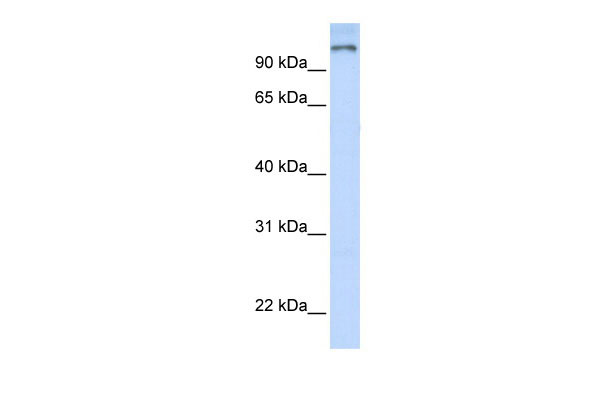PARP9 antibody - N-terminal region
Rabbit Polyclonal Antibody
- 产品详情
- 实验流程
Application
| WB |
|---|---|
| Primary Accession | Q8IXQ6 |
| Other Accession | NM_031458, NP_113646 |
| Reactivity | Human |
| Predicted | Human |
| Host | Rabbit |
| Clonality | Polyclonal |
| Calculated MW | 96343 Da |
| Gene ID | 83666 |
|---|---|
| Alias Symbol | BAL, BAL1, DKFZp666B0810, DKFZp686M15238, FLJ26637, FLJ41418, MGC:7868 |
| Other Names | Poly [ADP-ribose] polymerase 9, PARP-9, 2.4.2.30, ADP-ribosyltransferase diphtheria toxin-like 9, ARTD9, B aggressive lymphoma protein, PARP9, BAL, BAL1 |
| Format | Liquid. Purified antibody supplied in 1x PBS buffer with 0.09% (w/v) sodium azide and 2% sucrose. |
| Reconstitution & Storage | Add 50 ul of distilled water. Final anti-PARP9 antibody concentration is 1 mg/ml in PBS buffer with 2% sucrose. For longer periods of storage, store at 20°C. Avoid repeat freeze-thaw cycles. |
| Precautions | PARP9 antibody - N-terminal region is for research use only and not for use in diagnostic or therapeutic procedures. |
| Name | PARP9 |
|---|---|
| Function | ADP-ribosyltransferase which, in association with E3 ligase DTX3L, plays a role in DNA damage repair and in immune responses including interferon-mediated antiviral defenses (PubMed:16809771, PubMed:23230272, PubMed:26479788, PubMed:27796300). Within the complex, enhances DTX3L E3 ligase activity which is further enhanced by PARP9 binding to poly(ADP-ribose) (PubMed:28525742). In association with DTX3L and in presence of E1 and E2 enzymes, mediates NAD(+)-dependent mono-ADP-ribosylation of ubiquitin which prevents ubiquitin conjugation to substrates such as histones (PubMed:28525742). During DNA repair, PARP1 recruits PARP9/BAL1-DTX3L complex to DNA damage sites via PARP9 binding to ribosylated PARP1 (PubMed:23230272). Subsequent PARP1- dependent PARP9/BAL1-DTX3L-mediated ubiquitination promotes the rapid and specific recruitment of 53BP1/TP53BP1, UIMC1/RAP80, and BRCA1 to DNA damage sites (PubMed:23230272, PubMed:28525742). In response to DNA damage, PARP9-DTX3L complex is required for efficient non-homologous end joining (NHEJ); the complex function is negatively modulated by PARP9 activity (PubMed:28525742). Dispensable for B-cell receptor (BCR) assembly through V(D)J recombination and class switch recombination (CSR) (By similarity). In macrophages, positively regulates pro- inflammatory cytokines production in response to IFNG stimulation by suppressing PARP14-mediated STAT1 ADP-ribosylation and thus promoting STAT1 phosphorylation (PubMed:27796300). Also suppresses PARP14- mediated STAT6 ADP-ribosylation (PubMed:27796300). |
| Cellular Location | Cytoplasm, cytosol. Nucleus. Note=Shuttles between the nucleus and the cytosol (PubMed:16809771). Translocates to the nucleus in response to IFNG or IFNB1 stimulation (PubMed:26479788). Export to the cytosol depends on the interaction with DTX3L (PubMed:16809771). Localizes at sites of DNA damage in a PARP1-dependent manner (PubMed:23230272, PubMed:28525742). |
| Tissue Location | Expressed in lymphocyte-rich tissues, spleen, lymph nodes, peripheral blood lymphocytes and colonic mucosa (PubMed:11110709, PubMed:16809771). Expressed in macrophages (PubMed:27796300). Also expressed in nonhematopoietic tissues such as heart and skeletal muscle (PubMed:11110709, PubMed:16809771). Isoform 2 is the predominant form (PubMed:11110709). Most abundantly expressed in lymphomas with a brisk host inflammatory response (PubMed:11110709, PubMed:16809771). In diffuse large B-cell lymphomas tumors, expressed specifically by malignant B-cells (PubMed:11110709, PubMed:16809771) |
Research Areas
For Research Use Only. Not For Use In Diagnostic Procedures.
Application Protocols
Provided below are standard protocols that you may find useful for product applications.
REFERENCES
Juszczynski,P., (2006) Mol. Cell. Biol. 26 (14), 5348-5359 Reconstitution and Storage:For short term use, store at 2-8C up to 1 week. For long term storage, store at -20C in small aliquots to prevent freeze-thaw cycles.
终于等到您。ABCEPTA(百远生物)抗体产品。
点击下方“我要评价 ”按钮提交您的反馈信息,您的反馈和评价是我们最宝贵的财富之一,
我们将在1-3个工作日内处理您的反馈信息。
如有疑问,联系:0512-88856768 tech-china@abcepta.com.























 癌症的基本特征包括细胞增殖、血管生成、迁移、凋亡逃避机制和细胞永生等。找到癌症发生过程中这些通路的关键标记物和对应的抗体用于检测至关重要。
癌症的基本特征包括细胞增殖、血管生成、迁移、凋亡逃避机制和细胞永生等。找到癌症发生过程中这些通路的关键标记物和对应的抗体用于检测至关重要。 为您推荐一个泛素化位点预测神器——泛素化分析工具,可以为您的蛋白的泛素化位点作出预测和评分。
为您推荐一个泛素化位点预测神器——泛素化分析工具,可以为您的蛋白的泛素化位点作出预测和评分。 细胞自噬受体图形绘图工具为你的蛋白的细胞受体结合位点作出预测和评分,识别结合到自噬通路中的蛋白是非常重要的,便于让我们理解自噬在正常生理、病理过程中的作用,如发育、细胞分化、神经退化性疾病、压力条件下、感染和癌症。
细胞自噬受体图形绘图工具为你的蛋白的细胞受体结合位点作出预测和评分,识别结合到自噬通路中的蛋白是非常重要的,便于让我们理解自噬在正常生理、病理过程中的作用,如发育、细胞分化、神经退化性疾病、压力条件下、感染和癌症。






